- Clone
- RL2 (See other available formats)
- Regulatory Status
- RUO
- Isotype
- Mouse IgG1, κ
- Ave. Rating
- Submit a Review
- Product Citations
- publications
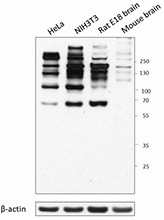
-
Same amount (15 µg) of total protein harvested from HeLa, NIH3T3, rat E18 brain, and mouse brain were resolved by electrophoresis, transferred to nitrocellulose, and probed with purified monoclonal O-GlcNAc (clone RL2) antibody. Proteins were visualized using a goat anti-mouse-IgG secondary antibody conjugated to HRP and chemiluminescence detection.
| Cat # | Size | Price | Quantity Check Availability | Save | ||
|---|---|---|---|---|---|---|
| 677902 | 100 µg | £238 | ||||
The monoclonal antibody RL2 reacts specifically with beta-O-linked N-acetylglucosamine (O-GlcNAc). It recognizes o-GlcNAc in beta O-glycosidic linkage to both serine and threonine. However, it exhibits no cross reactivity with alpha-linked Ser-O-linked N-acetylgalactosamine or N-linked oligosaccharides on ovalbumin and immunoglobulin. This antibody readily detects in vivo changes in O-GlcNAc modification1.
O-GlcNAc is one of the most abundant posttranslational modifications within the nucleocytoplasmic compartments of all metazoans2. O-GlcNAcylation is similar to protein phosphorylation. Research on O-GlcNAc is particularly relevant to chronic human diseases such as diabetes, cardiovascualr disease, neurodegenerative disorders, and cancer3.
Like phosphorylation, the specific functions of O-GlcNAc depend on the protein and sites to which the glycan is attached2. One of the major functions of O-GlcNAc is to prevent O-phosphorylation and to modulate signaling and transcription in response to cellular nutrients or stress4.
Product Details
- Verified Reactivity
- Human, Mouse, Rat
- Reported Reactivity
- Other species
- Antibody Type
- Monoclonal
- Host Species
- Mouse
- Immunogen
- O-GlcNAc in beta-O-glycosidic linkage to both serine and threonine.
- Formulation
- Phosphate-buffered solution, pH 7.2, containing 0.09% sodium azide.
- Preparation
- The antibody was purified by affinity chromatography.
- Concentration
- 0.5 mg/mL
- Storage & Handling
- The antibody solution should be stored undiluted between 2°C and 8°C.
- Application
-
WB - Quality tested
ICC, IHC, IP - Reported in the literature, not verified in house - Recommended Usage
-
Each lot of this antibody is quality control tested by Western blotting. For Western blotting, the suggested use of this reagent is 0.5 - 2.5 µg per mL. It is recommended that the reagent be titrated for optimal performance for each application.
-
Application References
(PubMed link indicates BioLegend citation) -
- Snow CM, et al. 1987. J. Cell Biol. 104:1143.
- Shin SH, et al. 2011. Amino Acids 40:885-93.
- Mi W, et al. 2011. Biochim. Biophys. Acta. 4:514.
- Hoedt E, et al. 2010. J. Biol. Chem. 285:19205.
- Product Citations
-
- RRID
-
AB_2565912 (BioLegend Cat. No. 677902)
Antigen Details
- Structure
- O-GlcNAc modified protein.
- Distribution
-
Nucleus and cytoplasm.
- Function
- To prevent O-phosphorylation and to modulate signaling and transcription in response to cellular nutrients or stress.
- Biology Area
- Cell Biology, Signal Transduction, Transcription Factors
- Molecular Family
- Protein Kinases/Phosphatase
- Antigen References
-
1. Comer FI, et al. 2001. Anal Biochem. 293:169.
2. Hart, GW and Akimoto, Y. (2009) Essentials of Glycobiology, 2nd edition. Cold Spring Harbor, NY: Cold Spring Harbor Laboratory Press.
3. de Queiroz RM, et al. 2014. Front Oncol. 4:132.
4. Hart GW, et al. 2014. Cell Metab. 20:208. - Gene ID
- 8473 View all products for this Gene ID
- UniProt
- View information about O-GlcNAc on UniProt.org
Related Pages & Pathways
Pages
Related FAQs
Other Formats
View All O-GlcNAc Reagents Request Custom Conjugation| Description | Clone | Applications |
|---|---|---|
| Purified anti-O-GlcNAc | RL2 | WB,ICC,IHC,IP |
Customers Also Purchased
Compare Data Across All Formats
This data display is provided for general comparisons between formats.
Your actual data may vary due to variations in samples, target cells, instruments and their settings, staining conditions, and other factors.
If you need assistance with selecting the best format contact our expert technical support team.
-
Purified anti-O-GlcNAc
Same amount (15 µg) of total protein harvested from HeLa, NI...
 Login / Register
Login / Register 





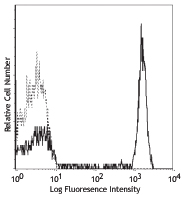
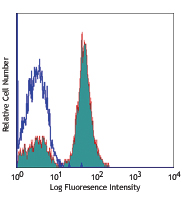

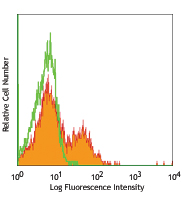
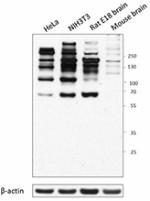



Follow Us